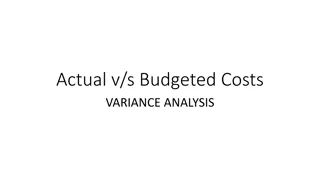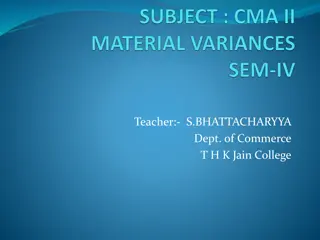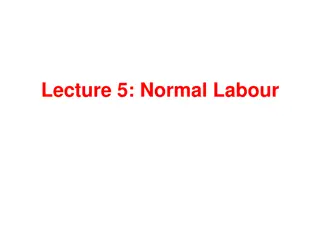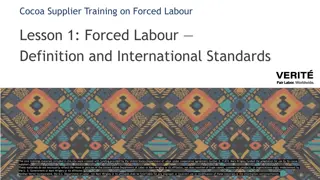Understanding Material and Labour Variances in Accounting
Material variances in accounting comprise cost, price, usage, mix, and yield variances, each reflecting differences between standard and actual costs, prices, quantities, compositions, and yields of materials used. Labour variances include cost, rate, total efficiency, and efficiency variances, analyzing discrepancies in labor costs, rates, and efficiencies. Understanding these variances is crucial for identifying cost discrepancies and improving operational efficiency in accounting practices.
Download Presentation

Please find below an Image/Link to download the presentation.
The content on the website is provided AS IS for your information and personal use only. It may not be sold, licensed, or shared on other websites without obtaining consent from the author. Download presentation by click this link. If you encounter any issues during the download, it is possible that the publisher has removed the file from their server.
E N D
Presentation Transcript
Material variances 1) Material cost variance 2) Material price variance 3) Material usage or quantity variance 4) Material mix variance 5) Material yield variance
1) Material cost variance material cost variance it is the difference between the standard cost of materials allowed for the output achieved and the actual cost of material used. Material cost variance = standard cost of material for actual output actual cost of material used or Material cost variance = material price variance + material usage variance
2) Material price variance - it is that portion of material cost variance which is due to difference between the standard price of material used for the output achieved and the actual price of material used. Material price variance = actual usage( standard unit price actual unit price) 3) Material usage variance it is that portion of the material cost variance which is due to the difference between the standard quantity of material specified for the actual output and the actual quantity of material used. Material usage variance = standard price per unit(standard quantity actual quantity)
4)Material mix variance - It is that portion of material usage variance which is due to difference between standard and the actual composition of a mixture. In other words, this variance arises because the ratio of materials being changed from the standard ratio. 1) when actual weight of mix and standard rate of mix do not differ : Standard unit cost(standard quantity actual quantity) 2) when actual weight of mix differs from standard weight of mix : [(Total weight of actual mix/total weight of revised std. mix) X Std. cost of revised std. mix] Std. cost of actual mix
5) Material yield variance It is that portion of material usage variance which is due to difference between the standard yield specified and the actual yield obtained. 1) When standard and actual mix do not differ : Yield variance = std. rate(actual yield standard yield) 2) when actual mix differs from standard mix : Yield variance = standard rate (actual yield revised standard yield)
Labour variances can be analysed as follows : 1) Labour cost variance (LCV) 2) Labour rate variance (LRV) 3) Total labour efficiency variance (TLEV) or labour efficiancy variance unadjusted 4) Labour efficiancy variance (LEV) 5) Labour idle time variance (LITV) 6) Labour mix variance or gang composition variance (LMV or GCV) 7) Labour yield variance or labour efficiency sub variance (LYV or LESV) 8) Substitution variance
1) Labour cost variance - it is the difference between the standard cost of labour allowed for the actual output achieved and the actual cost of labour employed. It is also known as wages variance. This variance is expressed as : Labour cost variance = standard cost of labour actual cost of labour 2) labour rate variance - it is that portion of the labour cost variance which arises due to the difference between the standard rate specified and the actual rate paid. It is calculated as follows : Rate of pay variance = actual time taken (standard rate actual rate)
3) Total labour efficiency variance - it is that part of labour cost variance which arises due to the difference between standard labour cost of standard time for actual output and standard cost of actual time paid for. It is calculated as follows : Total labour efficiency variance = standard rate (standard time for actual output actual time paid for) 4) labour efficiency variance - it is that portion of labour cost variance which arises due to the difference between the standard labour hours specified for the output achieved and the actual labour hours spent. It is expressed as : Labour efficiency variance = Standard rate (standard time for actual output actual time worked)
5) Labour idle time variance - it is calculated only when there is abnormal idle time. It is that portion of labour cost variance which is due to the abnormal idle time of workers. This variance is shown separately to show the effect of abnormal causes affecting production like power failure, breakdown of machinery, shortage of materials etc. while calculating labour efficiency variance, abnormal idle time is deducted from actual time expected to ascertain the real efficiency of the workers. Labour idle time variance is expressed as : Idle time variance = Abnormal idle time x standard rate Or Idle time variance = St.rate(actual hours worked actual hours paid)
6) Labour mix variance or gang com position variance it is like materials mix variance and is a part of labour efficiency variance. This variance shows to management as to how much of the labour cost variance is due to change in the composition of labour force. It is calculated as follows : 1) when there is no change in the standard composition labour force and total time expended is equal to the total standard time, the formula is : Labour mix variance = Standard cost of standard composition(for actual time taken) Standard cost of actual composition(for actual time worked)
Sales Variances The analysis of variances will be completed only when the difference between the actual profits and standard profits is fully analyzed .It is necessary to make an analysis of sales variances. Sales variances may be calculated by two ways. These may be computed as to show the effect on profits or these may be calculated to show effect on sales volume.























